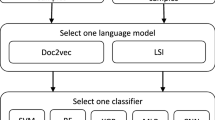Abstract
With the rapid development of information technology, a large number of sensitive words have appeared, which has brought great harm to network security and social stability. Therefore, how to identify and classify these sensitive information accurately has become an important issue. Combined with the improved artificial network algorithm, an adaptive classification algorithm is proposed in the experiment, which can provide local intelligent classification service according to the classification results. At the same time, the algorithm transforms the clustering model structure of the traditional network algorithm, introduces the classification information, so that it can be applied to the classification problem, and expands the application field of the data field theory. The experimental results show that: (1) From the experimental results of different text quantities, the SOM algorithm assigns the classification task to different levels of nodes, and realizes the modularization of detection. (2) The overall mean results show that the highest recall rate is 87%, which has met the basic grading criteria, and the detection accuracy of sensitive words will also be improved. (3) The experimental results show that the algorithm can accurately classify the sensitive and speed up the parameter optimization, and is superior to the comparison algorithm in many indicators. (4) From the simulation results, compared with the traditional neural network algorithm, the precision and recall of the algorithm are maintained at more than 90% and the loss is less than 0.11.






Similar content being viewed by others
Data availability
The original contributions presented in this study are included in the article/supplementary material, further inquiries can be directed to the corresponding author.
References
Chen X, Zhang J, Li X et al (2011) A text classification method for chinese sensitive web page recognition. Meas Control Technol 05:27–31
Dai G, She J (2012) Dictionary improvement and implementation based on double array Trie tree algorithm. Softw Guide 07:17–19
Dai X, Lin X, Zhou X (2009) Research on clustering method of pattern neural network. J Beijing Inst Petrochem Technol 17(004):13–16
Du D, Mu Z, Chen J, Fang X (2007) A multi-layer self-organizing neural network for simulating the cognitive process of chinese characters. J Univ Sci Technol Beijing 29(001):102–106
Han K, Wang Y (2000) A nonlinear weighted method for subject extraction. Chin J Inform Sci 06:650–653
He J (2008) A new method to realize the peripheral contour of Chinese characters. Comput Digit Eng 36(012):149–151
Huo L, Xu W, Zhao Y (2013) Design and implementation of embedded license plate recognition system. Comput Technol Dev 05(4):206–208
Li W (2020) Design of web sensitive word filtering and sensitive text classification system. Comput Knowl Technol 16(08):251–253
Li G, Li X, He X (2005) Application of improved ART1 neural network in fault diagnosis of aero-engine. Microcomput Inform 21(09S):156–158
Liu Z (2017) Chinese character image font recognition based on CNN network. Mod Comput 21(5):67–70
Liu Q, Li Y, Yang D (2016) Summary of knowledge map construction technology. Comput Res Dev 53(3):582–600
Mo H, Guan F, Lu S (2007) Research on multi-class and multi-dimensional problems of artificial immune memory classifier. Comput Eng Sci 29(2):100–103
Shi X (2006) Development and application of artificial neural network. J Chongqing Inst Sci Technol Nat Sci Edit 8(002):99–101
Suo H, Liu Y, Cao S (2006) A keyword extraction method based on lexical chain. Chin J Inform 06:25–30
Tong X, Zhu J (2006) Rough classification of off-line handwritten Chinese character recognition with large character set. Comput Appl 26(B06):24–26
Wu Y, Zhao M (2001) Neuron model with adjustable activation function and its supervised learning and application. Sci China E Ser 31(003):263–272
Yang Z, Yan Y (2006) Research and development of som neural network algorithms. Comput Eng 32:16
Yang F, Li H, Tian X (2009) chinese character rough classification based on RBF neural network. Comput Eng Appl 45(006):170–172
Yu P, Liu B (2004) Improved ART1 network and its application in english character recognition. J Yunnan Univ Nat Sci Edit 26(5):397–400
Zeng J, Wang X (2014) A novel KNN classification algorithm based on Mahalanobis distance. Mod Comput 32:7–12
Zhang S, Pan X (2011) Research on a novel text classification method based on Mahalanobis distance. J Changchun Inst Technol Nat Sci Edit 02:102–105
Zhou X, Lin X, Chen X, Li Y (2008) An improved artificial neural network model. Compt Eng Appl 44(009):64–66
Zuo L, Tan M (2002) Data clustering based on ART1 artificial neural network. Comput Eng Sci 24(2):92–95
Funding
The authors have not disclosed any funding.
Author information
Authors and Affiliations
Contributions
The authors participated in the preparation and presentation of the manuscript.
Corresponding author
Ethics declarations
Conflict of interest
The authors declare that the research was conducted in the absence of any commercial or financial relationships that could be construed as a potential conflict of interest.
Additional information
Publisher's Note
Springer Nature remains neutral with regard to jurisdictional claims in published maps and institutional affiliations.
Rights and permissions
Springer Nature or its licensor (e.g. a society or other partner) holds exclusive rights to this article under a publishing agreement with the author(s) or other rightsholder(s); author self-archiving of the accepted manuscript version of this article is solely governed by the terms of such publishing agreement and applicable law.
About this article
Cite this article
Gu, H., Li, Q. & Shen, D. Research on sensitive text classification detection and classification based on improved artificial neural network. J Comb Optim 46, 20 (2023). https://doi.org/10.1007/s10878-023-01085-8
Accepted:
Published:
DOI: https://doi.org/10.1007/s10878-023-01085-8




